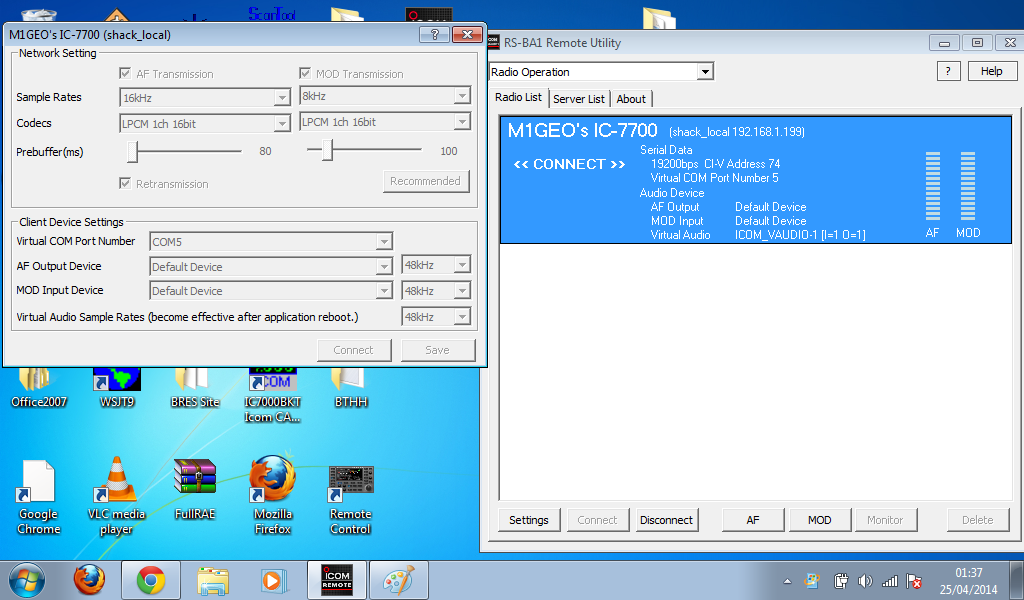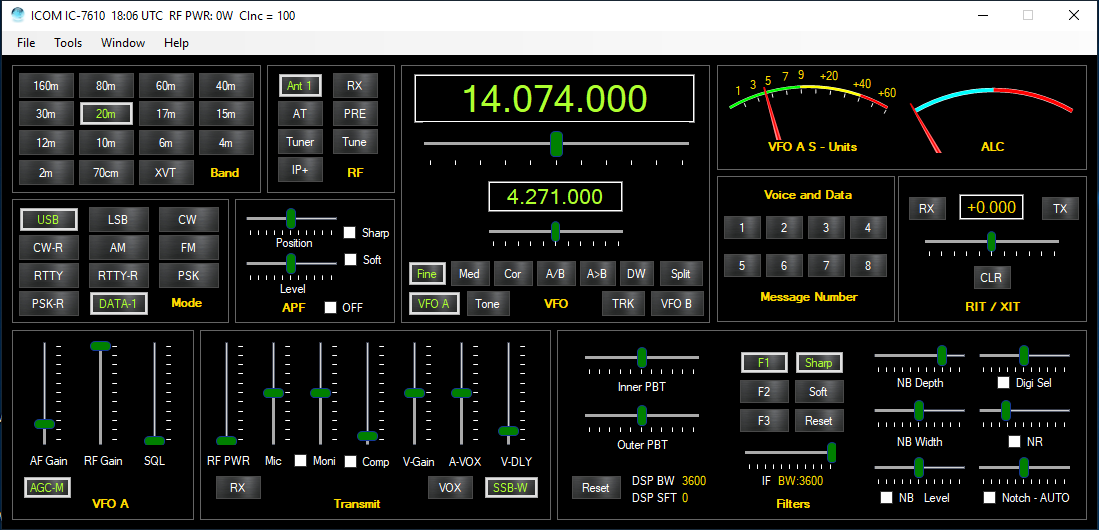ICOM® CI-V Electrical Interface James Michener K9JM One problem with the ICOM® CI-V communication bus, is that they never defined the electrical specifications for this interface. In the most basic terms, the bus is a single wire, which when active is pulled low. Conceptually, the above schematic shows two items connected to the single wire bus. Download Database. Welcome to the Icom America Download Database. Instruction manuals, brochures and other items are available by radio model.
Connecting an Icom Transceiver to your PC
The Icom CI-V Interface. This is a complete online manual to the interface and the software driving it. The page on CI-V level converters has links to many different circuits, including a relatively complicated one using the MAX232 chip. G3VGR Icom CI-V Interface. This is a nice little circuit using a couple of 2N2222s, two diodes, and four.
Computer control of the IC-7100, IC-7200, IC-7300, IC-7410, IC-7600, IC-7610, IC-7700, IC-7850, IC-7851, IC-9100, and IC-9700 is accomplished with a simple USB transceiver-to-computer connection.
Computer control of older Icom transceivers is accomplished via a bidirectional CI-V bus, which uses an asynchronous protocol communicated via TTL voltage levels. Thus an external interface between your Computer and your transceiver's CI-V jack is required. The basic function of the interface is voltage level conversion from the RS-232 levels used in a standard serial port (+12 and -12 VDC) and the TTL levels used by your transceiver's CI-V bus (+5, and 0 VDC). The interface itself requires power, which can be provided either externally, or with some interfaces by using one of the serial port modem control signals as a power source.
- Icom,Global,Land Mobile,Marine,Aviation,Amateur,Receivers,Satellite,LTE,WLAN,IP,Digital,Analog,Radio,Network,D-STAR.
- Feb 01, 2019 The way that I use it is with a CI-V cable for the WSJTX program. Then I can use the ICOM as the radio in WSJTX and the CI-V cable as the serial port in WSJTX. My USB cable is using HRD for rig control. You just need to have “Unlink from REMOTE” set in the radio to use two cables. Have a look at this. Take care and best 73!
Recent Icom transceivers can be switched between RX and TX using CI-V commands: IC-756Pro, IC-756ProII, IC-756ProIII, IC-7000, IC-7100, IC-7200, IC-7300, IC-7410, IC-7600, IC-7610, IC-7700, IC-7850, IC-7851, IC-9100, and IC-9700. All other Icom transceivers requires an external circuit that drives the tranceiver's SEND input (pin 3 on the backpanel ACC1 or ACC2 connectors). Commander can be configured to drive this external circuit from the serial port's modem control signal (DTR or RTS), or from a parallel port's pin 17.
There are two decisions that will drive your choice:
1. do you want to use one of your PC's serial ports, or one of its USB ports?
2. would you prefer to build something or buy it?

Being able to choose #1 is a relatively new option. Previously, controlling a transceiver via USB port meant purchasing a USB-to- serial-port adaptor (e.g. from Belkin or ByteRunner) and connecting it to your interface's serial port. Now, however, there are off-the- shelf USB interfaces; see, for example http://www.microham-usa.com/Products/USB.html . You can also build one of these yourself, as described in http://www.eham.net/articles/8192 ; if you go this route, be sure to read the comments, as the circuit as presented contains an (easily correctable) defect.
If your PC has a spare serial port, or you'd prefer an outboard USB- to-serial-port converter, then you'll have many more choices with respect to the interface - down both the 'buy it' and 'build it' paths.
If you use one of your PC's USB ports, configure Windows to not automatically power down this port.
Commercial Interfaces
- ICOM CT-17 (does not provide RX-TX switching for older Icom radios, as described above)
microHAM USB Interface II
Black Cat Systems (does not provide RX-TX switching for older Icom radios, as described above)
Piexx USB to CI-V interface
ZLP Electronics CT-17 replacements (does not provide RX-TX switching for older Icom radios, as described above)
*Interfaces known to work with 32-bit and 64-bit flavors of Windows 7 and Vista
You'll find product reviews of the above, along with more alternatives at http://www.eham.net/reviews/products/53 .

Home-brew interfaces
Building a interface is a nice little project that can be accomplished in an afternoon, including the trip to Radio Shack and back. This circuit was published many years ago in QST; its very reliable, and you may already have the necessary parts laying around:
Another nice circuit,
http://www.seed-solutions.com/gregordy/Amateur%20Radio/Experimentation/CIVInterface.htm
uses the MAX-232 IC for level conversion rather than discrete transistors. It also includes a circuit to control your 706's PTT circuit using one of the serial port modem control signals, which you'll find convenient if you're planning to operate digital modes.
This circuit is small enough to build into a DB9 connector shell:
http://www.qsl.net/g3vgr/civ.html
This module could be used as the foundation of a homebrew USB interface; be sure to drive the CI-V bus with an open-collector driver like the 7417:
http://www.sparkfun.com/commerce/product_info.php?products_id=8165
If your transceiver requires an external interface for RX-TX switching, you can use
- a circuit based on an opto-isolator
- a circuit based on an NPN transistor
Post a question or suggestion on the DXLab Discussion Group
Icom Ci V Software Windows 10
Choosing a Cable to Connect One RS232 Connector to Another
Getting Started with Icom Transceiver Control
Transceiver Control
Usb Ci V Icom Interface
Getting Started with DXLab
Before I introduce this project I want to list all the Icom programs I've written over the years:

- EasyTuner (1998) — An Excel spreadsheet with an associated communications library that allowed users to make spreadsheet entries for each desired memory. Windows only.
- RadioComm (1999) — A desktop application that controlled an Icom radio as well as programming its memories. Windows only.
- IcomControl (2000) — A radio controller that only controlled the Icom IC-PCR1000 headless radio. Windows only.
- Icom Programmer (2010, Ruby) — This program's predecessor, it was a Ruby project meant to program an Icom radio's memories, not be a radio controller in the usual sense.
- JRX (2012) — My most recent general-purpose Icom virtual radio, written in Java, much more sophisticated than its predecessors, but it controls the radio, it doesn't program its memories (reasons below).
IcomProgrammer II is meant to program an Icom radio's memories, not be a control panel, and it doesn't have a desktop user interface — for a true virtual radio that does, see JRX. This is the most recent, and by far the best, of my efforts to program the memories of my Icom radios. It's written in Python 3 and was developed on a Linux platform, but it should function on Windows with reasonable care during installation and operation.
Icom Ci-v Software
When I wrote the earlier Ruby program I had a smaller set of radios that needed programming, but at the moment I have these Icom radios:
- IC-7000
- IC-706MKII
- IC-746
- IC-756Pro
- IC-R8500
- IC-PCR1000
- IC-PCR1500
The IC-7000 is my most recent acquisition, and it is a terrific radio. I bought it so I could have a compact, sophisticated radio on my boat to replace the IC-706MKII, which, although fully operational, is far behind the times in a technical sense. But to fully exploit this new radio, I needed to replace my previous programming method written in Ruby. Among the problems with the prior method are that it didn't program memory names (alphanumeric labels), for those Icom radios that have this ability. (As it turns out, every one of my Icom transceivers accepts memory labels except the IC-706MKII.) Another problem was that the Ruby program didn't communicate with the radio very fast for a reason I didn't understand at the time. Both these issues are addressed in this new project.